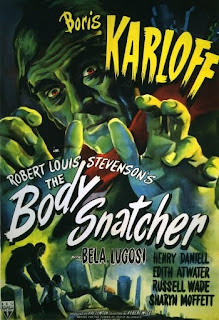The Body Snatcher
 The Body Snatcher, from 1945, is a dandy horror picture from producer Val Lewton and director Robert Wise. Though it does not use supernatural elements, it's more in the tradition of the classic Universal horror style, going so far as to use two of their mainstays, Boris Karloff and Bela Lugosi (and would be the last to feature both of them).
The Body Snatcher, from 1945, is a dandy horror picture from producer Val Lewton and director Robert Wise. Though it does not use supernatural elements, it's more in the tradition of the classic Universal horror style, going so far as to use two of their mainstays, Boris Karloff and Bela Lugosi (and would be the last to feature both of them).Based on a story by Robert Louis Stevenson and set in Edinburgh in 1831, the film springboards from the notorious Burke and Hare murders of four years earlier. Karloff, a cabman, has a sideline of grave-robbing to supply bodies to a medical school run by Henry Daniell. Russell Wade, as Daniell's assistant, is uneasy about accepting stolen corpses, but Daniell tells him that until the laws are changed (they can only use the corpses of the executed) it's a necessity for medicine to advance.
We know Karloff is a baddie early on when he robs a grave and kills the little dog keeping vigil on top of it. After that, though, the graveyards are kept well-protected. Wade, hoping to help a little girl with a spinal tumor, unwittingly prompts Karloff to murder when he says they must have a specimen. Karloff realizes this method is a lot easier.
The film makes great use of dark shadows, and Karloff is at the top of his game, with his smiling villainy. Daniell is also terrific. He made a career of playing smooth-talking cads, but in this role we see the full scope of the man. He's a concerned doctor, but he rationalizes and compromises too much, and it ends up costing him.
There's a chilling scene in which Karloff, looking for a warm body, follows a street singer as she goes under a bridge. She retreats into darkness, and the cab follows her, also being swallowed in darkness. She is continually singing, until a few moments after we see nothing, her song is cut off--brilliantly done.


Comments
Post a Comment